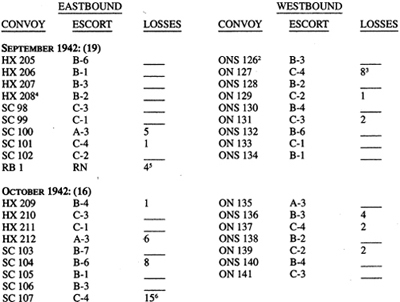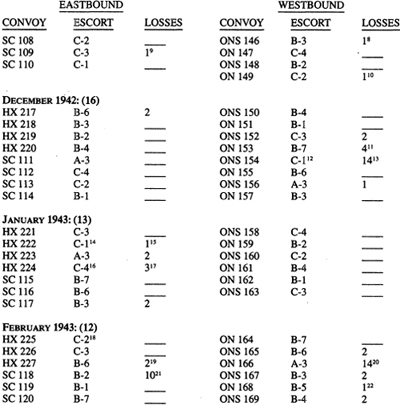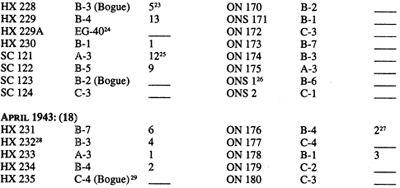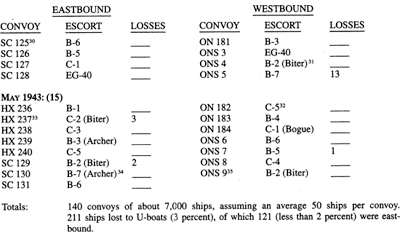
ALLIED CARGO-CONVOY SAILINGS ON THE NORTH ATLANTIC RUN
IN THE “CRITICAPLE RIOD”S:E PTEMBE1R94 2-MAY 1943’

NOVEMBER 1942: (15)
Note: In November 1942, Axis submarines in all waters sank 126 Allied ships for 802,160 gross tons, the best month of the war for the U-boats (see Appendix 20). Some historians and authors use the November 1942 figures to assert or imply that in so doing, German U-boats very nearly cut the vital North Atlantic convoy “lifeline” between the Americas and the British Isles. In fact, Jürgen Rohwer (Successes) states that German U-boats operating against the North Atlantic convoy “lifeline” in November sank twenty-nine cargo ships for 166,662 gross tons: fifteen loaded eastbound ships from Slow Convoy 107 for 82,817 tons, six empty westbound ships from Outbound North (Slow) 144 for 26,321 tons, and one ship each from Slow Convoy 109, Outbound North 143, and Outbound North 145 for an aggregate 19,524 tons, plus five cargo vessels sailing outside convoys for 38,000 tons. The other ninety-seven ships for 635,492 tons, Rohwer states, were sunk in other waters—for example, thirty in the Indian Ocean. For other examples, see Plates 3 and 4.

MARCH 1943: (16)
Note: In March 1943, Axis submarines in all waters sank 110 Allied ships for 633,731 tons, the third-best month of the war in tonnage sunk by U-boats (see Appendix 18, Volume I, and Appendix 20, this volume). Rohwer states that of the 110 ships lost, forty loaded eastbound ships were sunk on the North Atlantic “lifeline” from convoys Halifax 227, 228, 229, 230, and Slow Convoys 121 and 122, three empty westbound ships from Outbound North 168 and Outbound North (Slow) 169, and four other ships sailing outside convoys. Total in the North Atlantic area in March: forty-seven ships, the worst Allied setback of the war on that “lifeline.” The other sixty-three ships, Rohwer states, were sunk in other waters—for example, twenty-three in the Mediterranean Sea and the Indian Ocean.


1. Based on data in Jürgen Rohwer’s Critical Convoy Battles of March, 1943 and Axis Submarine Successes, and British Monthly Anti-Submarine Reports and, other sources. Losses include stragglers and rompers.
2. ON 125 was the first westbound convoy to terminate in New York.
3. Including Canadian destroyer Ottawa I.
4. HX 208 and SC 102 were the first eastbound convoys to sail from New York. The first departed on 9/17, the second on 9/19. The official Canadian historian wrote that convoys HX 1 to HX 207 from Halifax had sailed with 8,501 ships and SC 1 to SC 94 had sailed with 3,652 ships. SC 95 (8/4/42) to SC 101 (318 ships) sailed from Halifax, not Sydney. All told: 12,471 vessels.
5. Including British destroyer Veteran.
6. All ships of SC 107 were sunk in November.
7. Including Norwegian corvette Montbretia.
8. Sunk in December.
9. Badly damaged on 11/18, this ship, the 9,100-ton American tanker Brilliant, sank under tow on 1/25/43.
10. Sunk in December. Two other ships of this convoy were sunk in December after leaving it to sail alone.
11. Including British destroyer Firedrake.
12. On 1/1/43, the escort was reinforced halfway across the Atlantic by a new (1942) U.S. Navy fleet destroyer, Pringle. She was one of six U.S. destroyers (DD 476 to DD 481) fitted with a catapult and derrick to launch and recover an OS2U Kingfisher floatplane. The scheme was a failure; all six destroyers were restored to standard fighting configuration.
13. Plus two 10-ton LCVs.
14. Upon arrival in the British Isles, group withdrawn for training.
15. Plus three 143-ton LCT landing craft.
16. Upon arrival in the British Isles, group withdrawn for training,
17. All ships sunk in February.
18. Upon arrival in the British Isles, group withdrawn for training.
19. One of these, the Liberty ship Meriwether Lewis, was sunk in March.
20. Plus two tankers damaged and towed to St. John’s.
21. Plus one 143-ton LCT landing craft
22. Sunk in March.
23. Including British destroyer Harvester. The American “jeep” carrier Bogue hunter-killer group inaugurated operations with convoy Halifax 228, but after a few days she returned to Argentia on 3/14. She resailed 3/20 with SC 123 but returned again to Argentia on 3/30 and then to Boston for repairs.
24. A KM MK escort group that sailed directly from the British Isles on 3/3/43, to St. John’s specifically to escort special convoy Halifax 229A.
25. Plus one 143-ton LCT landing craft.
26. After convoy Outbound North (Slow) 171, slow westbound convoys were designated by a new numerical sequence and terminated in Halifax, beginning with Outbound North (Slow) 1.
27. Including ex-American British four-stack destroyer Beverley.
28. Sailed from New York on 4/1 at night in dense fog and became intermingled with convoy UGS 7, resulting in collisions and aborts that reduced ships sailing in HX 232 from fifty to thirty-four.
29. For the first time, on 4/23, Bogue, with five destroyers, sailed with a convoy all the way across the Atlantic to Belfast, where she was fitted with Huff Duff. She returned to the Americas in company with ON 184 in May.
30. Commencing with SC 125 on 3/31, Slow Convoys sailed from Halifax.
31. The British Support Group 5, consisting of the “jeep” carrier Biter and four destroyers, sailed from Iceland on 4/21 and inaugurated westbound operations with Outbound North (Slow) 4. Thus Biter and Bogue were at sea in the Greenland “Air Gap” at the same time.
32. A new Canadian MOEF group: new destroyers Ottawa II and Kootenay and five corvettes, in effect replacing A-3.
33. The British Support Group 5, consisting of “jeep” carrier Biter and three destroyers, inaugurated eastbound operations with HX 237 and SC 129.
34. The British Support Group 4, consisting of the “jeep” carrier Archer, three destroyers, and one sloop, inaugurated eastbound operations with HX 239.
35. The first merchant aircraft carrier (MAC ship), Empire Mac Alpine, 8,200 tons, sailed with ONS 9, carrying four Swordfish aircraft. Loaded with grain, she returned to the U.K. with SC 135, which sailed from Halifax on 6/27.